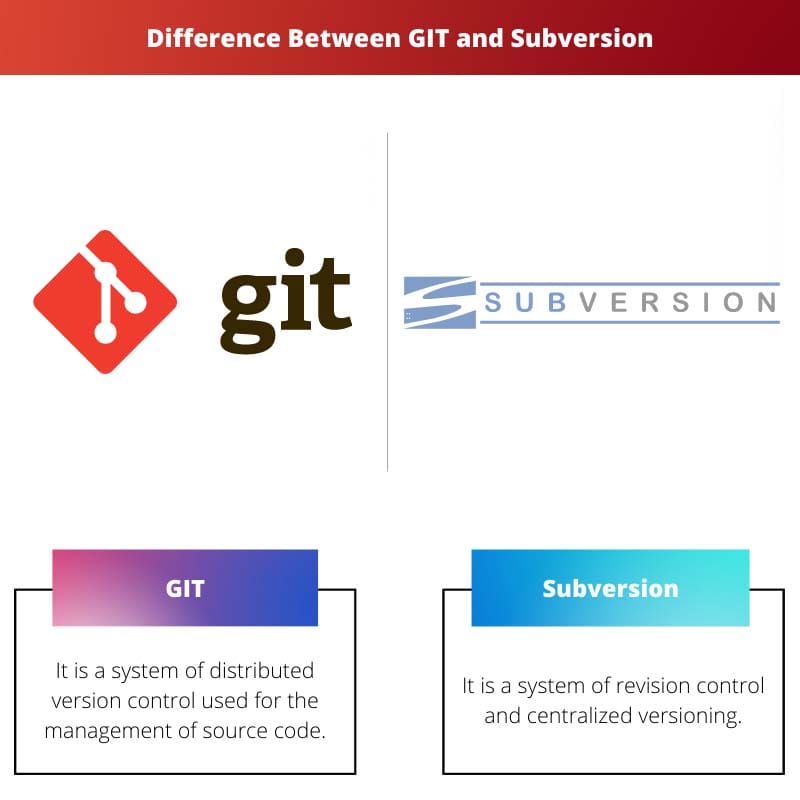Regarding software engineering, VCS or version control system is a components of software configuration management. It is a class of systems responsible for running changes to documents, computer programs, or other collections of information.
It runs as a standalone application but is also embedded in several software. GIT and subversion are two of the enterprise version control system.
They help with project and workflow management in coding. Sometimes, people get confused between both of these VCSs.
So, this article highlights the differences between GIT and subversion to clear up the confusion.
Key Takeaways
- Git is a distributed version control system, while Subversion is centralized.
- Git allows for easier branching and merging compared to Subversion.
- Subversion stores revision numbers, while Git uses unique hashes for commits.
GIT vs Subversion
GIT is known for its speed, flexibility, and the ability to handle large projects with many contributors, is a distributed version control system developed by Linus Torvalds. Subversion, also known as SVN, is a centralized version control system developed by Apache Software Foundation.

In 2005, GIT was developed by Linus Torvalds. It focuses on data integrity and speed in which there is no need for centralized connectivity.
It is cheap and powerful branching with easy merges. In this, each developer has a local copy and this repository in which they can change history.
Subversion manages folders and files that are present in the repository. Due to its network accessibility, it can be used and allow people to operate on different computers.
Every user has their code copy on their local like own branch.
Comparison Table
| Parameters of Comparison | GIT | Subversion |
|---|---|---|
| Interpretation | It is a system of distributed version control used for the management of source code | It is a system of revision control and centralized versioning. |
| Subproject | Git submodule | SVN external |
| Global revision number | Does not have | Does have |
| Network access | Not mandatory | Must require |
| Used by | 90% of professional developers | 10% of professional developers |
What is GIT?
GIT is software used for tracking changes in any set of files. The goals of GIT are data integrity, speed, non-linear workflows, and support for distribution.
It coordinates work among programmers collaborating to develop source code during software development. It becomes slow while dealing with a large number of files, such as binary files.
GIT is open-source and free software that is distributed under the license of GPL-2. 0-only. On every computer, every GIT directory has a full-fledged repository with full version tracking abilities and complete history.
It is also independent of a central server or network access. To sum up, the contents are checked cryptographically, which uses SHA- I hash algorithm.
The inspiration for GIT design is Monotone and Bitkeeper. It was originally designed as a low-level version control system engine on top of StGIT or Cogito.
It supports merging and rapid branching and includes a specific tool for navigating and visualizing a non-linear development history. According to Torvalds, it as being very scalable and fast.
Mozilla did performance tests which showed that it was a magnitude order faster than some version control systems. It stores each new object which is created as an individual.
Individually they are compressed and take up a great deal of space.
What is Subversion?
Subversion is a software revision control and versioning system dispersal as open-source under the license Apache. Software developers use it to maintain historical and current versions of files, including documentation, source code, and web pages.
The objective of subversion is to be the well-matched successor of the CVS or Control Version System, which is widely used. In 2000, the creator was CollabNet Inc. and currently, an Apache project at the top level is being constructed and used by the community of contributors globally.
The package of Berkeley DB was used by the original version of the subversion. There were some limitations, too, in that the database terminates or crashes forcibly while accessing a program.
But no corruption or data loss occurs. SVN external is the subproject of subversion. Perforce uses the model of inter-file branching to apply tagging and branches.
The separate line of development is known as a branch. This way, tagging describes repository labelling at a point in time and is easily found in the future.
Main Differences Between GIT and Subversion
- GIT creates a local repository instead of using a centralized server to store everything locally, whereas, in source code, subversion uses a centralized server to store changes.
- When it comes to content integrity, GIT contents are checked cryptographically, which uses SHA- I hash algorithm to sum up, while hashed contents are not included in subversion.
- In terms of learnability, GIT has more commands and concepts, making learning difficult. On the other hand, subversion is much easier to learn in comparison to GIT.
- The UI of GIT is not good as compared to the subversion. On the flip side, subversion has a better and simple user interface.
- GIT becomes slow while dealing with a large number of files, such as binary files that change quickly. But subversion easily controls a large number of binary files.



